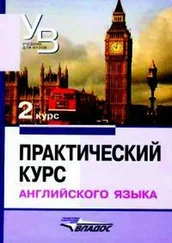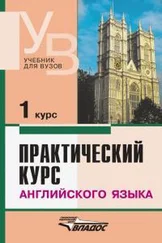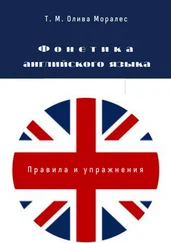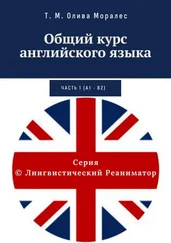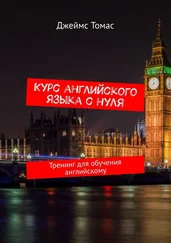Владимир Аракин - Практический курс английского языка 1 курс. Ключи
Здесь есть возможность читать онлайн «Владимир Аракин - Практический курс английского языка 1 курс. Ключи» весь текст электронной книги совершенно бесплатно (целиком полную версию без сокращений). В некоторых случаях можно слушать аудио, скачать через торрент в формате fb2 и присутствует краткое содержание. Год выпуска: 1998, Издательство: ВЛАДОС, Жанр: tbg_higher, на русском языке. Описание произведения, (предисловие) а так же отзывы посетителей доступны на портале библиотеки ЛибКат.
- Название:Практический курс английского языка 1 курс. Ключи
- Автор:
- Издательство:ВЛАДОС
- Жанр:
- Год:1998
- ISBN:нет данных
- Рейтинг книги:5 / 5. Голосов: 1
-
Избранное:Добавить в избранное
- Отзывы:
-
Ваша оценка:
- 100
- 1
- 2
- 3
- 4
- 5
Практический курс английского языка 1 курс. Ключи: краткое содержание, описание и аннотация
Предлагаем к чтению аннотацию, описание, краткое содержание или предисловие (зависит от того, что написал сам автор книги «Практический курс английского языка 1 курс. Ключи»). Если вы не нашли необходимую информацию о книге — напишите в комментариях, мы постараемся отыскать её.
Учебник является первой частью серии комплексных учебников для
I - V курсов педагогических вузов.
Цель учебника – обучение устной речи на основе развития необходимых автоматизированных речевых навыков, развитие техники чтения, а также навыков письменной речи.
Практический курс английского языка 1 курс. Ключи — читать онлайн бесплатно полную книгу (весь текст) целиком
Ниже представлен текст книги, разбитый по страницам. Система сохранения места последней прочитанной страницы, позволяет с удобством читать онлайн бесплатно книгу «Практический курс английского языка 1 курс. Ключи», без необходимости каждый раз заново искать на чём Вы остановились. Поставьте закладку, и сможете в любой момент перейти на страницу, на которой закончили чтение.
Интервал:
Закладка:
Lesson Six
Ex. VII, p, 76
1. Her full name is Elizabeth Louise Smith.
2. She is a college graduate. She is a writer, just a beginner,
3. Yes. she has. She has got many companions.
4. Yes, they are. Her companions are kind and jolly.
5. Belly'a elder sister, Helen, ia married to Henry Sandford, 6– Yes. she is. Betty is a member of her sister's family.
7. Her brother-in-law is a doctor.
8. He has a mother, but he has no father.
9. No, she isn't. Helen is a housewife.
10. They have only one child. Benny.
11. Betty's nephew is four.
12, Yes. he is. But sometimes he is naughty.
13– He is fond of birds and animals.
14. No, he isn't. He Is eager to haves rabbit.
15. Yes, they have. They have got many animals and birds in the house.
Ex, IX, p. 76
1, my mother's brother 2. my sister's friend 3 r his daughter's husband 4, my parents' house 5. my father's table 6. my mother's work 7. this student's notebook 8. these students' notebooks 9. my friend's sister 10, onr cousin's friend 11. my grandfather's photo 12. Pete's room 13. her brother's son 14. Ann's daughter 15. my mother's sister
Ex. XaJ, p. 77
1. What faculty are you students of?
2. What is her brother-in-law?
3. What is Betty Smith?
4. Whn t is ni у s ister-iii-1 aw ?
5. Is his family large?
6. How many children have they got?
7. Has she got a sou or a daughter?
8. What is their child's name?
9. What is her name?
10. How old is his nephew?
11. Where is he?
12. Is she a German student?
13. Whoae sister is Betty?
14. What has she got on the table?
15. Has Benny any brothers?
16. What age ia their grandmother of?
17. What age is Dr. Sandford of?
Ex. XII, p. 77
1. cousin 2. grandfather 3. nephew 4. niece 5. uncle 6. aunt 7. eouain 3. grandmother 9. sister-in-law 10, brother-in-law
Ex. XIII, p. 77
1. am 2. is 3. are 4. is. are 5. are fl. Is 7. Are 8. ia 0. are. am 10. are.arell. Are 12. Are 13. areI4,Isl5, is 16. am 17. am lS.lsie. ia
Ex. XIV, p. 78
1. to 2. at, in. with 3, at 4. into 5. in 6. into 7. out of 8, in 9. into 10. from 11. in/under 12. to 13– to 14. out of 15. in 16. to 17. of 18. in 19. at 20. of. at 21. at, of
Ex. XV, p. 78
1. any, any 2, any, aomc 3. по. a 4. some / no 5. any, any 6. some / по 7. anyS.anyO, aomc/по 10. any. some 11, any, none 12. any 13. no / some 14. no / some
Ел, XVI, p. 78
writer, worker, teacher, reader, painter, singer, examiner, dancer, listener
Ex. XVII, p. 78
three, nine, eleven, twelve, fourteen, fifteen, nineteen, thirty three, forty-four, sixty, ninety-nine, a / one hundred
Ex, XVIII, p. 79
the first, the third, the fifth, the ninth, the nineteenth, the second, the fourth, the eighth, the twelfth, the twentieth
Ex. XIX, p. 79
Forty-six plus eighteen issixty-four.
Fifteen minus eight is seven.
Eighty minus thirty is fifty.
Nine plus eleven is twenty.
Four plus forty is forty-four.
Ten plus eight is eighteen.
Seventy-nine minus fifty is twenty-nine.
Ninety-niiie plus one Is a / one hundred.
Thirty divided by five is six.
Five multiplied by five is twenty-five.
Nine multiplied by nine is eighty'one.
Ten divided by two is five.
Ten divided by five is two.
Six multiplied by eight Is forty-eight.
Six multiplied by six Is thirty-six.
Twenty-seven divided by three is nine,
Ex. XX, p. 79
1. Take your books out of the bags and put them on the desks.
2. Open you books at page 79 and find Exercise Twenty On it.
3. Go to the blackboard and write Sentence One.
4. Come up nearer to the bookcase, will you?
5. Put your exercise books aside, will you?
6. Read Text 1 on page 33. will you?
7. Will you look at the picture, please? S r WiJI you close the window, please? 9. Will you, please, speak louder?
10– Plee.se, prepare you homework in time, will you?
Ex, XXI, p, 79
1. His friends are students of the English Faculty, They are future teachers.
2. Helen is Mr. Sand ford's wife.
3. How old is your niece?
4. How many brothers has James? — Only one.
5. He is married and haa a large family.
6– la your elder sister married? — Yes, she is. Her husband is я teacher of English-
7. Has he a nephew? — No, he hasn't– But he has a niece.
8. Take your books out of the / your bags.
9. Open your books at page Twenty-Seven. Юг You must read Lesson Six once more. 11, Read and translate Sentence Three.
Lesson : evan – 13
12. Do Exercise Eleven on page Thirty-Seven.
13. Fetch aome chalk from Room Fourteen.
14. She is a naughty / disobedient girl.
15– My schoolmate is very fond of animals f likes animals very much.
18. lam eager to have a dog in the house, but my parents are against it.
17. My daughter-in-law has no peace in the house because of
cats and dogs. 13, Most of her daughter's girlfriends are students.
19. Шв children are well-bred. SO. Nelly is a kind and jolly girl,
21, We are schoolmates and classmates.
22, He lives at 9, Lesnsya Street, Flat Fifteen.
23, Have you got a telephone? — Yes, I have. My telephone number is two one seven one eight three six.
24, He ia not so young as you think, he is already thirty. l'.'i My niece is as old as your grandson.
26. How old is your son? — He is ten years old / years of age. He is three years older than your daughter ie.
27. My cousin is two years and a half younger than 1 am.
28. My brother's daughter is only a year and a half,
29. Natasha is the youngest of my friends.
30. My parents and 1 live at 10, Peschanaya Street,
31. Add ten to ten.
32. Multiply five by seven,
33. If you divide thirty by six, you will get five.
Lesson Seven
в. Then? are girls in the picture.
7. There arc no children in their family.
Ex. Xi a), p. 01
1. Ia there a telegram on the table? There is no telegram on the table.
2. la there a cinema near our Ьоине? There is no cinema near our houae.
3. Are there many mistakes in his dictation? There are not many mistakes in his dictation,
4. Is there much paper in his hag? There is not much paper in his bag.
5. Are there twoaofas in the room? There яге not two sofns in the room.
Are there many children In theparlc (odayV There are not many children in the park today.
Ex. ВД p, ВТ
1. No. that's wrong. Doctor Sandford has no daughter, he has only a son г
2. No. that's wrong. There are five people in Doctor Sand-ford's family.
3. No. (hat's wrong. Doctor Sandford la thirty.
4– No h that^a wrong. There are no boys or girl sin the family for Benny to piny with.
5. No, that's wrong, Benny has two cousins.
6. No. that's wrong. Benny's cousins are in Canada.
7. No, that's wrong. Benny's cousins are not schoolchildren.
E-.HVabp. 92
1. What is there in the room? How many tables are there in l he room 7
2. What ia there in lierhag'MInw many notebooks are there in her bag?
3. What is there in the hall? How many students are there in the hall?
Lesson ^BYEn 17
4. What is there on (lie desk? How many clocks are there on the desk?
5. What la tbere In the laboratory? How many cassette recorders are {here in the laboratory?
6. What is there in the exercise? How many sentences are there in the exercise?
Ex. xvi b|p p. G2
1. How much coffee is there in the coffeepot? — There ia much coffee in the coffeepot,
2. How much water is there in the Klaus? — There is much water In the glass.
3. How much salt Is therein (hesoup? — There is (on much salt In (he soup.
4. How much money is there in the bag? — There is little money in the bag.
5. How much tea la there in the teapot? — There is much tea In the teapot.
6. How much butter la there on the plate? — There Is little butter on the plate,
Ex. XtfJl h p. 92
*. 1. There ia a picture on {he wall. There Is a cluck on the wall. There is a blackboard on the wall. There are pntatnea on the table r There are bonks on the table. There is milk in the jug. There is butter on the pla(e r There is salt on the table. There Is a sentence {wrIUen) on the blackboard.
2. The picture Is on wall. The clock is on the wall. The blackboard Ison (he wall. The boxes are on the table. The bags are on (he table. The books are on the table. The milk is in the jug. The butter is on the plate. The salt is on the table. The sentence is (written) on the blackboard.
3. Thereipolamponthetahle. The lamp is on (ho (able. There are newspapers on the table. The newspapers are on {he table. There la a car in the street. The car la In the street-There is a sofa near the wall. The sofa is near the wall. There are pencils in the box. The pencils are In (he box.
И - Койрохтнвний яурс
Ex. VII, р. 89
A– I. Yes, it is. This is a classroom.
2. No, there are not. There are not marly desks in it. There are fifteen desks here.
3. Yes, there are, Thereare(bomc)chairsin the room. There are thirty chairs in the room.
4. Yes. there are. There are (some) suspended lamps in the room.
ii. No, they are not. The lamps are not on the walls, в. There are eight lamps in the room.
7. There are three windows in the roam,
8. The walls are Jight-green (in colour),
9. The desks are beige (in colour).
10. The chairs are fawn (in colour).
11. Yes, there is. There is a blackboard on the wall.
12. The hoard Is green (in colour).
13. There are nine sentences on it.
14. There are seven books on my desk.
15. They are English.
16. There are three exercise books in my bag.
17. They are thick.
18. This book is thin,
10. There iaa cassette recorder on this table. 20. There arc pencils in that box. в. 1. Yes, it is. The box is on the desk.
2. Yes. they are. The pencils are in the bo*.
3. The bag is under the desk.
4. The fountain pen is in the bag,
5. The noiebook lain your hand, 8. The notebooks are on the desk.
7. The letters are under the book.
8. The picture is on the wall.
9. The chair is near the table,
10. The pens are in the box,
С 1. No, it isn't. Dr. Sandford's family is not very large.
2. Yes. he has. He has a wife.
3. Her name is Helen.
Lesson : even ■ 15
4. Yes. she has. She has a sister.
5. No. be hasn't. Dr. Sandford has no fsther.
6. Yes, he lias. He has a mother.
7. No. he hasn't. He has no daughter. H. Yes, he has. He has a son,
g r His name is Benny.
H3. There are five people in Dr. Sandford's family.
11. Dr. Sandford is thirty.
12. Helen is twenty-six.
13. Mrs. Sandford is fifty-eight.
14. Benny has two cousins.
15. George and May are Aunt Emily's children. 10, Benny's cousins pre in Canada now r
Ex. VIII, p. 90
1. There is a bus In the street.
2. There is a lamp in the room.
3. There is chalk at the blackboard,
4. There is bread on the table.
5. There is tea in the teapot.
6. There is coffee in the coffeepot,
7. There is money in the bag.
8. There is paper in the box.
9. There is soap on theshelf-
10. There is water in the jug.
Ex– IX. p. 90
1. at 2. past 3. at. to / past 4. past 5. to. at. at 6, from, till 7.in. of
Fx. X, p. 90
1. There are sentences on the blackboard.
2. Are there (any) desks in the room?
3. There are not any books on the table.
4. Are there (any) dictionaries on the chair?
5. There are matches in the box.
п т КорракшвнцЯ курс
4. There is no book on the chair. The book is not on theehair. There is no hat on the chair. The hat is not on the chair. There is no exercise book on the chsir r The exercise book is not on the chair. There is no pen in the box. The pen is not in the box. There is no money in the bag. The money is not in the bag.
5– There arc not three but four books in the hag. There arc not five hut six pencils in the bag. There are not two pens but one in the bag.
6, It's just the time for dinner. It's just the time for tea. в. 1. Thisis my room. There isa table in the middleof the room. There isa jug on the table. There is milk in the jug. There is butler on the plale.
2. Let Benny sit down to table. It's just the time for breakfast. The milk is in thejug. The butter is on the plate. The knife is near the plate. Where is the breed? The bread is in the sideboard.
3. Where is the magazine? There is no magazine on the table. The magazine is not on the table but on the chair.
4. There is no pen in the box. The pen is not in the box but in the table.
5. Where is the money? There is no money in the bag– Your money Is not in the bag– It Is on the table.
6. Are there many exercise books in your bag? — No. there are not many, two or three. — Is there much chalk on the board? — Yes, there is, I think so.
7. Are there many houses in your street? — Yes. there are-There are many beautiful new houses in our street. — Are there many flowers in your park? — Not so many, but I like them very much.
Ex. XVIII, p. 93
Model i: There isa lot of milk in the jug. There isa lot of sugar in the sugar howl. There is a lot of rubbish in the corner. There isa lot of juice in the carafe.
Model 2: There are a Lot of mistakes in the test paper. There arc a lot of dictionaries on the shelves. There are a lot of buttons on the coat. There are a lot of people in the room.
Интервал:
Закладка:
Похожие книги на «Практический курс английского языка 1 курс. Ключи»
Представляем Вашему вниманию похожие книги на «Практический курс английского языка 1 курс. Ключи» списком для выбора. Мы отобрали схожую по названию и смыслу литературу в надежде предоставить читателям больше вариантов отыскать новые, интересные, ещё непрочитанные произведения.
Обсуждение, отзывы о книге «Практический курс английского языка 1 курс. Ключи» и просто собственные мнения читателей. Оставьте ваши комментарии, напишите, что Вы думаете о произведении, его смысле или главных героях. Укажите что конкретно понравилось, а что нет, и почему Вы так считаете.
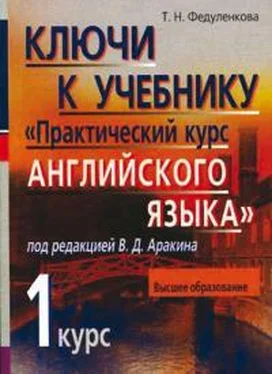
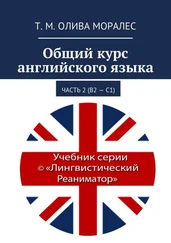

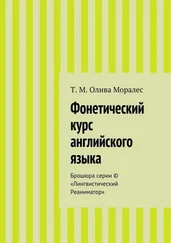
![Владимир Аракин - Практический курс английского языка 3 курс [calibre 2.43.0]](/books/402486/vladimir-arakin-prakticheskij-kurs-anglijskogo-yazyk-thumb.webp)
